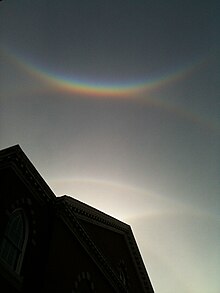Supralateral arc


A supralateral arc is a rare halo, an optical phenomenon often confused with the indeed infrequently appearing 46° halo. Distinguishing between the two is furthermore difficult as supralateral arcs typically only appears in fragments while the 46° halo is very faint.
In contrast to the static 46° halo, the shape of a supralateral arc varies with the elevation of the sun. Before the sun reaches 15°, the bases of the arc touches the lateral (oriented sidewise) sides of the 46° halo. As the sun rises from 15° to 27°, the supralateral arc almost overlap the 46° halo, why most reported observations of the latter most likely are observations of the former. As the sun goes from 27° to 32°, the apex of the arc touches the circumzenithal arc centred around zenith (as do the 46° halo when the sun is located between 15° and 27°). In addition, the supralateral arc is always located above the parhelic circle (below is the infralateral arc) and is never perfectly circular.[1][2]
Arguably the best way of distinguishing the halo from the arc is to carefully study the difference in colour and brightness. The 46° halo is six times fainter than the 22° halo and generally white with a possible red inner edge. The supralateral arc, in contrast, can even be confused with the rainbow with clear blue and green strokes.[1]
Supralateral arcs form when sun light enters horizontally oriented, rod-shaped hexagonal ice crystals through a hexagonal base and exits through one of the prism sides. Supralateral arcs occur about once a year.[1]
Gallery
-
Solar Halo, Upper Tangent Arc, Supralateral Arc : 20 June 2009 : Khonkaen, Thailand
See also
References
- ^ a b c "Supralateral arc". Arbeitskreis Meteore e.V. Retrieved 2007-04-16. (Including a photo from January 1996, a 1980 computer simulation of a supralateral arc relative to a 46° halo, and a table pinning down differences between 46° halos and supralateral arcs.)
- ^ "Supralateral Arcs". www.paraselene.de. Retrieved 2009-03-08.
External links
- Atmospheric Optics - Supralateral & infralateral arcs - including HaloSim computer simulations and crystal illustrations.
- paraselene.de - Gallery of images from March 2002
- paraselene.de - Gallery of images from December 2007

